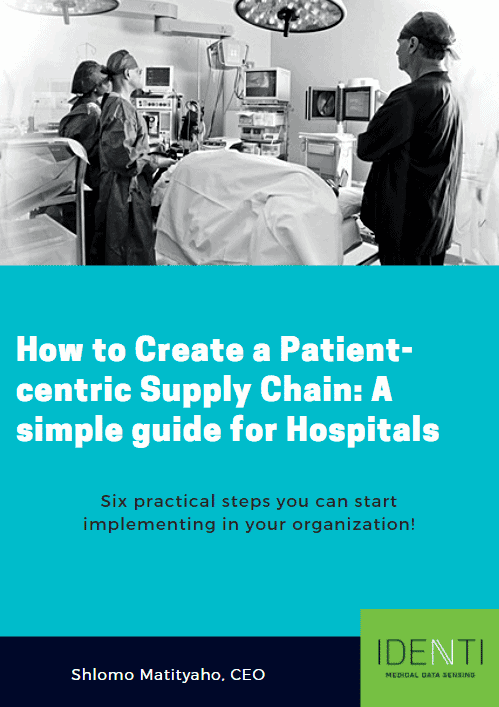What’s inside:
Supply chain management needs to strike a delicate balance between cost-effectiveness and patient-centricity. In this useful guide, we unravel the intricacies of creating a patient-centric supply chain, illuminating key strategies and best practices for hospitals.
Content:
- Understanding the importance of a patient-centric supply chain
- Fostering collaboration across departments
- Leveraging technology to enhance efficiency and transparency
- Implementing best practices for patient-centered inventory management
- Navigating challenges and overcoming obstacles on the path to patient-centricity
Importance of a patient-centric supply chain
A patient-centric supply chain is a model that prioritizes the needs, preferences, and well-being of the patient over traditional focuses. It reorients the entire logistics and distribution process to enhance the overall patient experience and improve health outcomes through key elements such as customization, transparency, and responsiveness.
Expanding patient-centric care in all areas of healthcare is not just an empty slogan. It’s a commitment we make as healthcare professionals to better the lives of the people we treat.
Whether patients select a hospital of their choice or are directed to one through their HMO, they rightfully expect “the system” to provide superb treatment. Patients cannot be expected to distinguish between the services provided by the clinical team and the staff supporting them. If an error occurs, such as implanting expired stock, it does not matter to the patient whether the responsibility is with the supplier who did not update the stock on time, the nurse who did not notice this, or the surgeon who did not bother to double-check. The hospital, as a whole, is guilty and will be held accountable.
According to an article written by the American Society of Radiologic Technologists:
“Most patients judge the quality of their healthcare much like they rate an airplane flight. Criteria for judging an airline are personal and include aspects like comfort, efficient service and on-time schedules. Similarly, patients judge the standard of their healthcare on nontechnical aspects. Most are unable to evaluate the level of technical skill or quality of therapy, so the conditions they can assess — patient satisfaction and preserving health over time — become of the utmost importance.”
Focusing on a patient-centric supply chain connects hospital operations, logistics, and clinical care data to ensure every decision supports patient outcomes, safety, and efficiency. This article outlines six practical steps hospitals can take to create a more cohesive, data-driven, patient-centered approach.
6 Steps to Build a Patient-Centric Supply Chain
Step 1: How to Synchronize Hospital Data Systems for Better Patient Safety
Achieve data alignment between clinical and operational data
Delivery of modern healthcare is set up so that patients travel through several separate institutions on their journey to wellness. At each step, new files will be opened within a multitude of systems: the patient management system, the clinical data system, the queue management system, and ERP systems. In best-case scenarios, all these diverse systems will be connected through a common interface. More often, the desired level of interconnectivity is just not there.
Although the operational information surrounding the patient is no less important than the clinical data needed for optimal patient treatment, today in most medical institutions, there is little or no correlation between these two data systems – it is impossible to know essential details about devices implanted in a patient by looking in the patient’s medical record.
Take, for example, hemodynamics monitoring systems, which are very good at data collection and interface effectively with most clinical systems. So why is this not the case on the operational side? Why is there no consolidation of essential data, such as serial number, date of expiration, and production series? A major roadblock to full integration of diverse data sources is the current standard of inventory management based on manufacturers’ bar code identification.
Often, the medical team finds it difficult to record device details accurately because of outdated manufacturers’ catalogs, multiple methods of cataloging the same products, and the introduction of unmarked items into the treatment room, which is particularly common during high-stress periods. The result is a lack of integrity of the recorded information and a low level of reliability, which, according to some reports, is below 60%.

A promising solution is to switch from bar code readers to optical character recognition (OCR) technology to capture data from operational inventory. OCR is already widely used in other areas of clinical medicine. For example, a tumor is optically captured (photographed) and the image is processed and analyzed for size, shape, location, and malignancy. OCR is now beginning to find its way into operational inventory management as well. On-site medical staff photographs the product as it is taken from the shelf. It is automatically input into the system, which recognizes the product and assigns the appropriate SKU. No time-consuming data entry, scanning, or searching through manufacturers’ catalogs.
Step 2: How to Move from Reactive to Proactive Inventory Management
Instead of putting out fires, prevent them in the first place
Ask any organizational consultant how to streamline your facility, and they’ll recommend that you switch from passive/reactive mode to an active/preventive approach. It is much easier to avoid mistakes before they happen than to fix them after the fact. In the healthcare industry, mistakes can be a matter of life and death.
Take, for example, intraocular lens implants. In most hospitals, such inventory is managed at the item level, when in fact it should be managed at the next level down, which in this case would be the various sizes for each item. Protocol dictates that a nurse physically verify that the correct lens size is available before surgery begins. Yet, sometimes patients are already on the operating table when it is discovered that the right-size lens is not in stock and needs to be urgently rushed in.
The solution is to adopt a fully automated system that can track each item down to its most unique characteristic — even items that cannot be tagged. Such a system reduces delays, identifies vulnerabilities, and resolves them autonomously. In this way, processes within the hospital departments AND with third-party suppliers are improved. More importantly, the patient experience is enhanced.
Step 3: How to Improve Supplier Collaboration in Healthcare
Improve cohesion throughout the supply chain
The supply chain includes several key stakeholders: the clinical team, the logistics department, vendors, distributors, GPOs, manufacturers, and more. The formula for operational success is healthy communications and respectful cooperation between all stakeholders. Today, suppliers understand that they, too, must bear responsibility towards patients, even if they are not in direct contact with them.
In recent years, many medical institutions have switched to a consignment-based supply system, forcing the relationship between buyer and supplier to take on a new dynamic. Unfortunately, the day-to-day procedures of this newly evolved supply chain are often only partially implemented. On one hand, the hospital no longer manages inventory; this task has shifted to suppliers. On the other hand, it is difficult for third-party distributors to successfully manage inventory over long distances without any real ability to monitor the inventory in real time. The result is a lack of control and chronic confusion that often creates friction between hospitals and suppliers.
Today, all sides understand that they must work together and that it is the hospital’s responsibility to create a common platform that provides full transparency so that suppliers can effectively manage inventory from afar. Any such platform must include intelligent, real-time tracking capabilities so that off-site suppliers can be more proactive at inventory stocking. This, in turn, enables them to provide quick, effective responses so that patient care is never compromised due to a lack of inventory.
Step 4: How to Choose the Right Automation and Technology
Choose the correct technology for the job
Whether using barcodes, RFID, or other available technologies, it is crucial to choose a solution that can fully meet the needs of your own medical supply chain for many years to come. We are living in the digital age, the most intelligent period man has known, surrounded by AI (artificial intelligence) solutions and other advanced digital systems. Even organizations that do not have the budget to invest in the latest cutting-edge technology can utilize the technologies they do have access to, looking for new ways to integrate them into existing operating rooms and inventory management systems.
Take, for example, the cardiac pacemaker. These implants require periodic attention, such as battery or device replacement. The key here to life-saving and cost-effective treatment is automated logistic tracking — the ability to manage the life span of the implants and provide a timely response from within an integrated platform that can alert the appropriate people at the proper time and at the correct location. Humans cannot be expected to keep track of all this; it’s just too complicated!
However, the task of identifying supply chain weak points, articulating needs, vetting technologies, and choosing the most suitable and comprehensive solutions should not be taken lightly. We are not talking about an off-the-shelf product, but a custom solution for each department and organization. The main goal is to provide the medical staff with the ability to act quickly and effectively, along with peace of mind, so that they can focus on their patients.
A successful platform will enable the management team to process data and generate insights that will promote healthy relationships with all hospital partners. When comprehensive supply chain systems are running smoothly, the safety and quality of patient care increase.
Step 5: How to Free Nurses from Inventory Tasks
Let nurses be nurses
Hospital supply chains have become sophisticated networks that manage massive inventories of a wide range of items and products, sourced from suppliers of all sizes and managed by numerous employees.
As a result of the organizational changes already mentioned in this article, much of the responsibility for managing inventory has shifted to nurses — the same nurses who administer hands-on patient care. On top of these responsibilities, nurses now find themselves troubled by inventory levels, expiration dates, and endless filling out of order forms. Procurement personnel, who are responsible for the operational aspects of the supply chain, often find themselves running after the medical staff for inventory-related updates.
In a patient-centric supply chain, the nursing staff are relieved of many of their current inventory duties so that they can once again focus their attention on patient care. A top-level, executive decision is needed, one that provides the bespoke tools that have the power to efficiently manage inventory and return the responsibility for operational management of medical inventory to the logistics team and third-party suppliers.
Step 6: How to Use AI to Strengthen Your Supply Chain Strategy
Leverage new technology to add speed and efficiency to hospital inventory management
Once a patient-centric supply chain management system has been implemented and optimized, there is one more step that can be taken to increase a system’s efficiency. That is to recruit artificial intelligence (AI) for analysis and reporting. After accumulating a reliable body of data, it can be interpreted to derive insights that will enable continued tweaking of the system for even better results. If in the past much of data analysis was overseen by humans (even if computers were crunching the numbers), today AI can do it faster and more effectively.
Marvin Minsky described it as “a way of making a machine behave in ways that would be called intelligent if a human were so behaving.” One of the areas that AI has successfully contributed to is in the sphere of logistics and resource management.
For hospitals to continue to align their patient-centric goals with recent developments in technology and the demand to maximize efficiencies, they will increasingly rely on AI, which is actually the next stage of automation. AI-based tools and insights are already enabling medical and logistics teams to enhance their performance in a way that supports their professional capabilities, rather than replacing them. This trend will surely continue to strengthen in the future.

Building the Future of Patient-Centric Care
A truly patient-centric supply chain unites data, technology, and human care under one goal: better outcomes.
Key Takeaways:
- Align data systems for traceability and safety.
- Use automation and AI to improve accuracy and responsiveness.
- Foster supplier partnerships for transparency.
- Free clinical staff to focus on patient care.
The result is a connected, intelligent healthcare ecosystem where every supply chain decision benefits the patient.
By: Shlomo Matityaho






